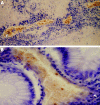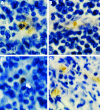Development of fetal haemoglobin-blood cells (F cells) within colorectal tumour tissues
- PMID: 16469830
- PMCID: PMC1860403
- DOI: 10.1136/jcp.2005.029934
Development of fetal haemoglobin-blood cells (F cells) within colorectal tumour tissues
Abstract
Aim: To evaluate the sources of fetal haemoglobin (HbF) as an indicator in cancer. An immunohistochemical study was carried out on some of the most common kinds of cancer. All of these cancers had serologically high levels of HbF as evaluated previously.
Methods: Immunoaffinity-purified anti-HbF was immunohistochemically used to study F cell distribution in the following cancers: colorectal adenocarcinoma, urinary bladder transitional cell carcinoma, brain tumours, lung carcinoma, breast adenocarcinoma, leukaemia, Burkitt's lymphoma and endometrial carcinoma.
Results: In colorectal adenocarcinoma, HbF-containing red blood cells (FRBC) were present within thin-walled vessels or were disposed in dense clusters within the tumour. Some of these cells were nucleated or binucleated HbF-erythroblasts or HbF-normoblasts (FNBS). In two cases, high levels of mitoses within HbF-erythroblasts were observed. In half of the cases with transitional cell carcinoma of the urinary bladder, regional intratumoral blood vessels were found to contain 5-50% FRBC. In the other tumours examined, F cells were not observed. FRBCs, however, were occasionally observed in the regional lymph nodes of some of these cancers.
Conclusions: The evaluation of HbF as a potential plasma marker is suggested by the high concentration of FRBCs in colorectal tumours. The apparent development of FRBCs in colorectal tumour tissues is an interesting observation, as these cells were previously thought to develop in medullary or lymphoid tissues. It is thus suggested that the colonic microenvironment may stimulate extramedullary fetal-type haematopoiesis.
Similar articles
-
Fetal haemopoiesis marking low-grade urinary bladder cancer.Br J Cancer. 2012 Jul 24;107(3):477-81. doi: 10.1038/bjc.2012.268. Epub 2012 Jun 26. Br J Cancer. 2012. PMID: 22735903 Free PMC article.
-
Foetal haemoglobin-blood cells (F-cells) as a feature of embryonic tumours (blastomas).Br J Cancer. 2007 Aug 6;97(3):412-9. doi: 10.1038/sj.bjc.6603867. Epub 2007 Jun 26. Br J Cancer. 2007. PMID: 17595660 Free PMC article.
-
Blood cells with fetal haemoglobin (F-cells) detected by immunohistochemistry as indicators of solid tumours.J Clin Pathol. 2004 Jul;57(7):740-5. doi: 10.1136/jcp.2003.013938. J Clin Pathol. 2004. PMID: 15220368 Free PMC article.
-
Expression of vascular endothelial growth factor receptor 3 in blood and lymphatic vessels of lung adenocarcinoma.J Pathol. 2001 Apr;193(4):450-7. doi: 10.1002/path.828. J Pathol. 2001. PMID: 11276003
-
Determinants of fetal hemoglobin response to hydroxyurea.Semin Hematol. 1997 Jul;34(3 Suppl 3):8-14. Semin Hematol. 1997. PMID: 9317196 Review.
Cited by
-
Fetal haemopoiesis marking low-grade urinary bladder cancer.Br J Cancer. 2012 Jul 24;107(3):477-81. doi: 10.1038/bjc.2012.268. Epub 2012 Jun 26. Br J Cancer. 2012. PMID: 22735903 Free PMC article.
-
Foetal haemoglobin-blood cells (F-cells) as a feature of embryonic tumours (blastomas).Br J Cancer. 2007 Aug 6;97(3):412-9. doi: 10.1038/sj.bjc.6603867. Epub 2007 Jun 26. Br J Cancer. 2007. PMID: 17595660 Free PMC article.
-
Evaluation of Automatic Blood Analyzer as Screening Method in Fetomaternal Hemorrhage.Biomed Res Int. 2019 Feb 26;2019:6481654. doi: 10.1155/2019/6481654. eCollection 2019. Biomed Res Int. 2019. PMID: 30931329 Free PMC article.
-
A phase I study of oral panobinostat (LBH589) in Japanese patients with advanced solid tumors.Invest New Drugs. 2012 Jun;30(3):1096-106. doi: 10.1007/s10637-011-9666-9. Epub 2011 Apr 12. Invest New Drugs. 2012. PMID: 21484248 Clinical Trial.
-
Blood and Cancer: Cancer Stem Cells as Origin of Hematopoietic Cells in Solid Tumor Microenvironments.Cells. 2020 May 22;9(5):1293. doi: 10.3390/cells9051293. Cells. 2020. PMID: 32455995 Free PMC article. Review.
References
-
- Bertles J F. Human fetal hemoglobin: significance in diseases. Ann N Y Acad Sci 1974241638–652. - PubMed
-
- Chudwin D S, Rucknagel D L, Scholnick A P. Fetal hemoglobin and α‐fetoprotein in various malignancies. Acta Haematol 197758288–293. - PubMed
-
- Wolk M, Newland A C, De la Salle B.et al Refinement of plasma fetal hemoglobin (HbF) measurements, as related to whole blood HbF, in cancer patients. J Tumor Marker Oncol 199914115–126.
-
- Lavelle D E. The molecular mechanism of fetal hemoglobin. Semin Hematol 200441(Suppl 6)3–10. - PubMed
MeSH terms
Substances
LinkOut - more resources
Full Text Sources
Medical




